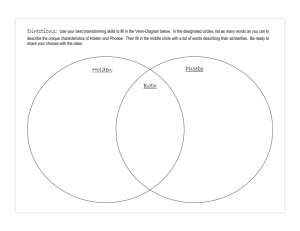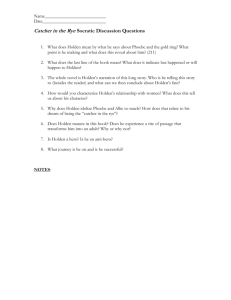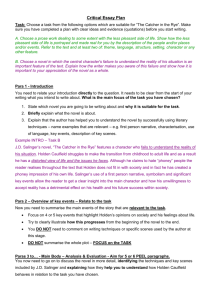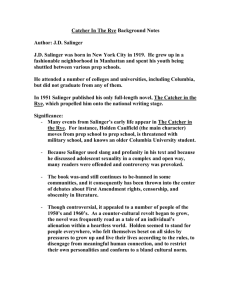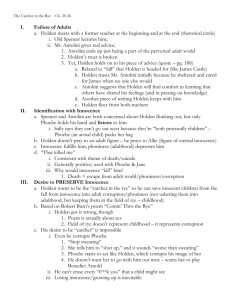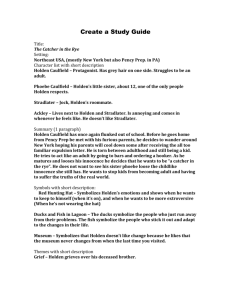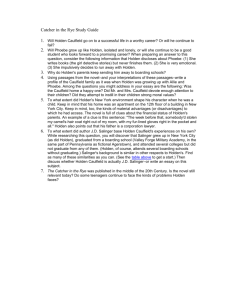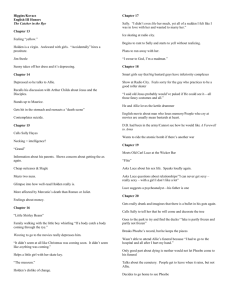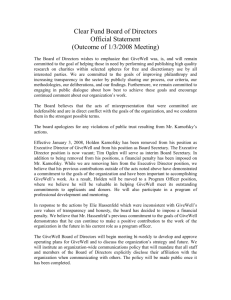here - Mark D. Pepper
advertisement
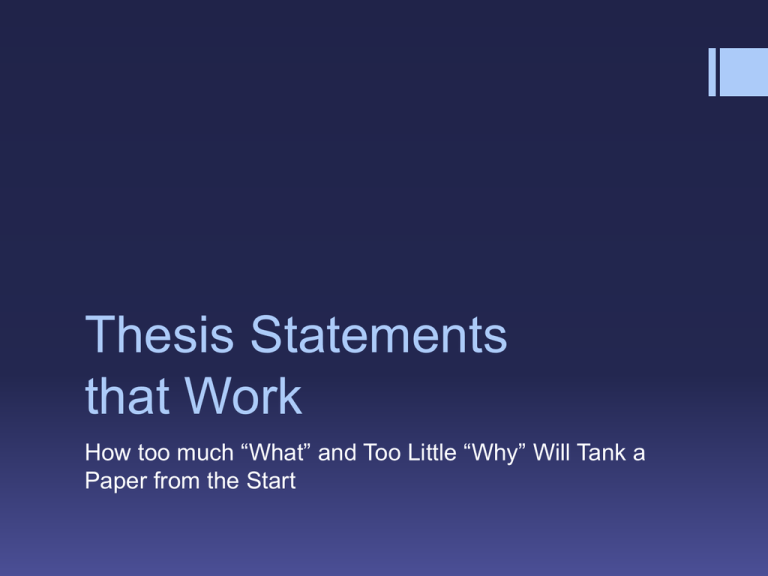
Thesis Statements that Work How too much “What” and Too Little “Why” Will Tank a Paper from the Start What is Your Claim & Why Should Anyone Care? The largest problems with early draft thesis statements: Not a specific enough analytical claim about the work(s) No sense of exigency or why this claim matters Too specific of a claim locks the author into a 5 paragraph essay organization Not Specific Enough White Noise highlights many tenets of postmodernism. Salinger creates the fascinating character of Holden Caulfield through a series of key interactions with the novel’s supporting cast. Edgar Allen Poe’s work was affected greatly by the current events of his childhood and career which subsequently affected his style and subject matter. Not Specific Enough White Noise highlights many tenets of postmodernism. What tenets? Why are these tenets being highlighted? Salinger creates the fascinating character of Holden Caulfield through a series of key interactions with the novel’s supporting cast. Why is he fascinating? Which interactions? What other cast members? Why are these other cast members being highlighted at the expense of others? Edgar Allen Poe’s work was affected greatly by the current events of his childhood and career which subsequently affected his style and subject matter. Which works will be discussed? What elements of his style? What areas of his subject matter? So What? No Sense of Exigency. In Huckleberry Finn, Twain develops a contrast between life on the river and life on the shore. All the characters in White Noise have specific and different coping devices to handle their conscious (and subconscious) fears about the fluidity of their identities. Through Holden’s interactions with both his sister Phoebe and his teacher Mr. Antolini, Salinger highlights Holden’s internal struggle between holding onto childhood innocence and avoiding the “phoniness” of being an adult. So What? No Sense of Exigency. In Huckleberry Finn, Twain develops a contrast between life on the river and life on the shore. Better: Through its contrasting river and shore scenes, Twain’s Huckleberry Finn suggests that to find the true expression of American ideals, one must leave “civilized” society and go back to nature. At a time where more and more Americans are moving into major cities, Twain’s suggestion is more relevant than ever and lends this aging novel continued relevance in today’s techno-industrial world. So What? No Sense of Exigency. All the characters in White Noise have specific and different coping devices to handle their conscious (and subconscious) fears about the fluidity of their identities. Better: Although all the characters in White Noise have different coping devices to handle their often subconscious fears about the fluidity of identity, Heinrich, Jack, and Murray have put the most conscious work into maintaining these specific devices. As identity continues to be a key touchstone for defining the postmodern condition, looking at these three men from different generations highlights how coping with unstable identity not only touches everyone but necessitates alternate methods at different ages. So What? No Sense of Exigency. Through Holden’s interactions with both his sister Phoebe and his teacher Mr. Antolini, Salinger highlights Holden’s internal struggle between holding onto childhood innocence and avoiding the “phoniness” of being an adult. Better: Through Holden’s interactions with both his sister Phoebe and his teacher Mr. Antolini, Salinger highlights Holden’s internal struggle between holding onto childhood innocence and avoiding the “phoniness” of being an adult. As much of the criticism on the novel views key scenes with Phoebe and Mr. Antolini as clear epiphany moments for Holden, highlighting Holden’s mixed feelings about both characters reveals a more complex take on the protagonist's’ growth. Too Specific All the characters in White Noise have specific and different coping devices to handle their conscious (and subconscious) fears about the fluidity of their identities. In particular, I will look at Jack’s “JAK Gladney” image, Heinrich’s questions about brain chemistry, and Murray’s plans for a course on car crashes in cinema to illustrate how each character consciously fashions a preferred identity for themselves. This will certainly lead to a 5-paragraph essay that discusses exactly these scenes with no reasoning behind the order of discussion. Even if a reason is given for the order through metacommentary, it’s still not a good thesis. Looking Forward Covering these 3 points/scenes is perfectly valid JAK Gladney Brain Chemistry Car Crash Seminar The key is to discuss them in a purposeful order so that the thesis and argument grows more complex through the discussion Instead of 3 points that randomly reference it but don’t build together An Orderly Reasoning I elect an outside to inside and order of importance organization 1. Car Crashes- to demonstrate that sometimes people look to others for identity cues (Murray is trying to model Jack’s success) JAK Gladney- to argue that Murray fails in his attempts, so others look to their own methods 2. 1. 3. Though others do encourage Jack to “fill into” his Hitler role so this harkens back to previous point Brain Chemistry- to suggest that neither inside or outside approaches can work because we’re perhaps ultimately under the control of brain chemistry that is beyond our control 1. Synthesizes previous two points and ends on the most provocative idea
